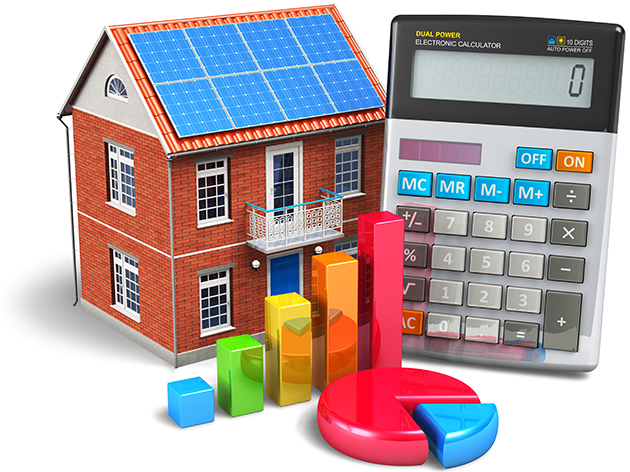Additional Mortgage Payment Calculator
 This free online calculator will show you how much you will save if you make 1/2 of your mortgage payment every two weeks instead of making a full mortgage payment once a month. In effect, you will be making one extra mortgage payment per year -- without hardly noticing the additional cash outflow. But, as you're about to discover, you will certainly notice the "increased" cash flow that will occur when you pay your mortgage off way ahead of schedule! But wait, this calculator will even show you what will happen if you go one step further by adding an additional amount of money to the monthly amount you're currently paying.
This free online calculator will show you how much you will save if you make 1/2 of your mortgage payment every two weeks instead of making a full mortgage payment once a month. In effect, you will be making one extra mortgage payment per year -- without hardly noticing the additional cash outflow. But, as you're about to discover, you will certainly notice the "increased" cash flow that will occur when you pay your mortgage off way ahead of schedule! But wait, this calculator will even show you what will happen if you go one step further by adding an additional amount of money to the monthly amount you're currently paying.
This calculator allows you to figure the savings by adding an extra amount to your fixed monthly payments & the potential savings by making biweekly payments. Enter your loan details, the extra monthly payment amount you would like to make & click calculate.
Today's Best El Monte Mortgage Rates
Our rate table lists the best current El Monte mortgage rates available from our lender network. Set your search criteria by entering your loan data and selecting the relevant products from the dropdown, click search and we'll help you compare the market by showing you the most relevant offers for El Monte homeowners.
Retiring a Mortgage with Extra Payments
Many homeowners invest in home security systems to protect their property and personal assets. However, a security system will not protect the homeowner against financial disaster or bankruptcy. Making additional mortgage payments will shrink the total amount of interest paid over the life of the loan, and the borrower will pay off the debt more quickly. In addition, the home equity will grow at a faster pace when extra payments are applied to the loan. This provides for a margin of protection by lowering the interest costs. This method gives the property owner a home free and clear of debt. More payments on the principal of the loan equate to assets earning interest at the same rate as the interest rate on the loan.

15 Year vs 30 Year Loans
If a borrower makes an extra annual payment, the savings on interest can be quite substantial. On a 30-year mortgage with the original principal total of $250,000 and an interest rate of 6.5 percent, the monthly payment is $1,580, including both principal and interest. By making the scheduled payments over the life of the loan, the total amount paid in interest will be $319,000. However, if the homeowner pays one additional monthly payment per year, the total interest paid declines to $249,000, a difference of $70,000. This payment strategy shortens the loan from 30 years to just over 24 years.
An alternative to making one extra monthly payment per year is to make a higher monthly payment. For example, on a 15-year loan of $300,000 at 5 percent interest, adding $200 to each monthly payment reduces the interest costs substantially. If the monthly payment is $2,372, making a payment of $2,572 saves $15,376 in interest over the life of the loan. The loan is paid in full in 13.4 years instead of 15 years.
Mortgage Cycling
Borrowers have a variety of options for paying off home loans prior to the maturity date. One popular method is called mortgage cycling. Although the concept may be new to some homeowners, the strategy has a proven record of accomplishment when followed correctly. The basic strategy is easy to understand. However, some methods of mortgage cycling may involve higher risk to reward ratios. These techniques include taking out short term home equity loans to make payments towards the principal of the original mortgage. Without an accurate analysis of the borrower's financial situation, it is possible that the riskier techniques can lead to higher interest costs and the prospect of foreclosure.
The basic method of mortgage cycling pays down the principal balance faster than scheduled. Borrowers make the standard mortgage payment. Then at regular intervals from once a year to every month, the homeowner pays an additional amount towards the principal balance. Frequently, the recommended method suggests making an extra payment equal to the principal amount owed on each monthly bill. For a $100,000 loan at 6 percent interest for 30 years, the monthly payment is $599.55. This breaks down to a payment of $500 towards interest and $99.55 towards the principal. With mortgage cycling, the borrower sends in an additional payment of $99.55 to be applied to the principal.
While not every borrower can schedule extra payments with standard frequency, extra payments can come from other sources. Even bi-annual payments of significant size can reduce the term of the loan and the total interest paid. Consumers without a regular source of additional funds have other options for taking advantage of mortgage cycling, such as using tax refunds or cutting back on luxuries.
Bi-weekly Payments
Bi-weekly payments are another popular way to pay extra on a mortgage. Given that there are 12 months and 52 weeks in a year, paying 26 bi-weekly payments is like paying 13 monthly payments, with the 13th payment going entirely toward the principal of the loan.
Finding the Extra Funds
Many homeowners do not consider making additional payments because they believe their budgets will not provide for extra funds. Yet, these same individuals may use credit cards to purchase big-ticket items such as televisions or the latest smart phone. They may not stop to calculate the monthly expense of a morning latte and scone. $6.00 spent every day on the way to work totals $120 monthly. A thorough analysis of the monthly budget can reveal many ways to save money that may be applied to the mortgage.
Tax refunds represent another source of additional funds to make payments on a home loan. Many taxpayers receive sizable refunds. These funds can be dedicated to the loan easily. Other sources can come from financial awards or settlements from insurance companies.
The speed at which a home loan can be retired varies depending on the extra amount paid and when it is applied to the principal. Making larger payments earlier in the term will save the borrower a considerable amount of interest. For example, for a $160,000 loan with 7 percent interest for 30 years, the payment would be $1064.40. Of that, only $131.83 is principal, and $932.57 is interest. If the consumer pays an additional amount equal to the principal, an entire month of the duration of the loan is eliminated.
Practicing this discipline on a monthly basis would reduce the standard 30-year loan to 15 years. However, as the loan progresses, the ratio of interest and principal inverts so that eventually the principal represents the majority of the payment. A borrower continues to match the principal amount with an additional payment. In the example above, after one year of additional payments, the principal amount would increase to $137.00. Thus, most homeowners should plan to adjust the budget as the loan matures.
While analyzing the various methods of making extra mortgage payments, consumers should consider their individual financial status. Some consumers may find that withdrawing large amounts from savings accounts can save thousands of dollars in interest expense on the mortgage. Yet, many financial advisors would caution against an overly aggressive application of this approach. Having a cushion of savings protects against unforeseen expenses and can provide financial security during times of economic difficulties. Stocks, bonds and other liquid assets can be sold to make additional mortgage payments. A careful analysis of the lost return on investment in comparison to the savings in interest should be taken into account. In addition, a consumer may wish to pay off high interest credit cards prior to applying additional funds to a mortgage. This may prove to be a better strategy as interest on mortgages is tax deductible whereas interest on unsecured credit is not tax deductible.
If the borrower cannot count on steady sources of additional funds, simply setting aside extra cash throughout the month for extra payments will still lower the total cost of interest paid. The amount can fluctuate from month to month.
Consider Taxes
Borrowers considering a strategy to pay off a home loan early using additional payments will need to calculate the effect on taxes as well. Interest paid on mortgages can be tax deductible. Thus, the government helps the homeowner make the payments by reducing taxes. On a 30-year loan with a 7 percent interest rate, the government pitches in 1.89 percent of the cost of interest through the tax deduction. This equates to 27 percent of the 7 percent rate on the loan. With the tax deduction, the effective mortgage rate is 5.11 percent. Depending on the economy and investment opportunities, the homeowner may be able to invest the additional money in higher yielding ventures. However, the rate of return on other investments will be taxed.
There are many reasons why homeowners may want to retire a mortgage early. For strictly financial reasons, a borrower will want to compare investment return rates after taxes. The effective rate includes actual tax benefits from the interest deduction. An interest rate of 4.5 percent may be much lower after the tax deduction. One key to making the early payment strategy work is to be consistent. One payment towards the principal will make a small dent in the balance due. However, when paid consistently over time, those payments will save the homeowner thousands of dollars in interest payments.
Key Tips & Advice
Things to consider when buying a home:
- While the 30-year mortgage is the most popular term in the United States, a 15-year term builds equity much quicker;
- Home buyers in the US move on average of once every 5 to 7 years;
- Early mortgage payments apply primarily to interest rather than the principal;
- Using a shorter loan term, paying extra & making bi-weekly payments can better help offset any transaction-based expenses.
Do Home Prices Always Go Up?
In the United States real estate prices have went up about 6-fold since 1970.


